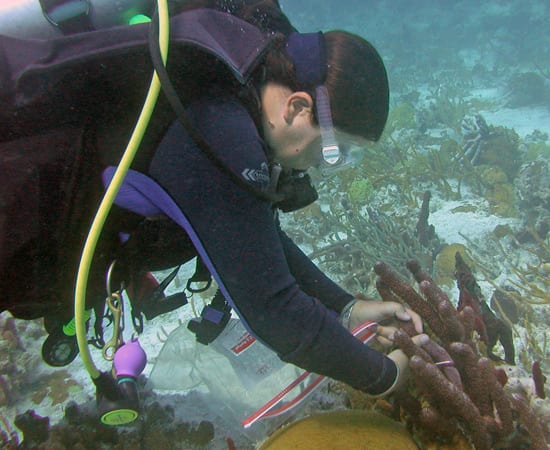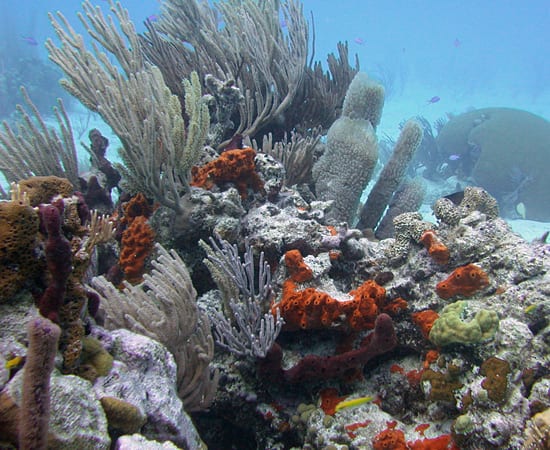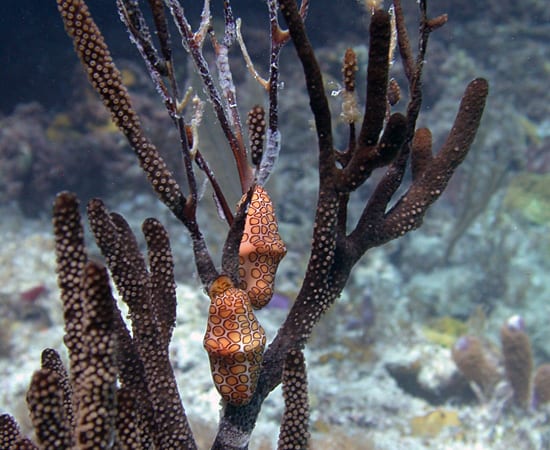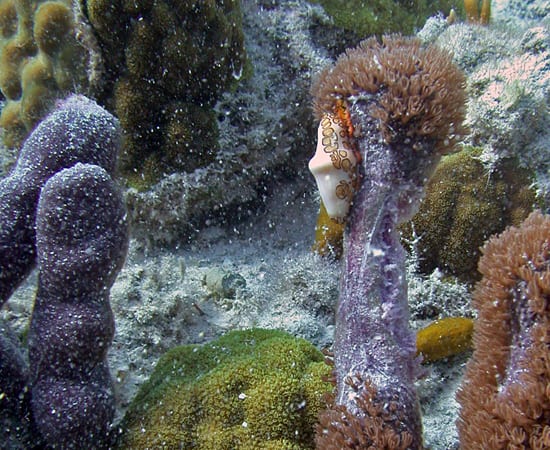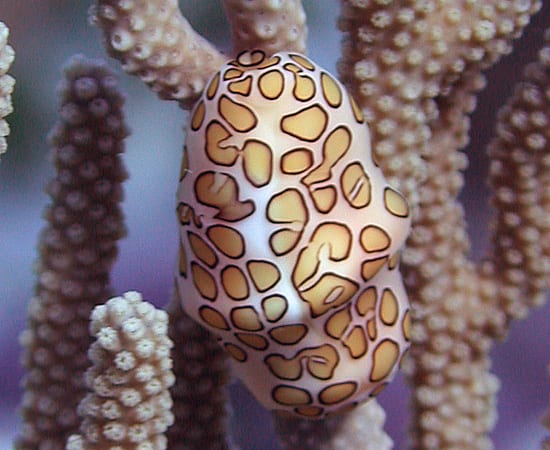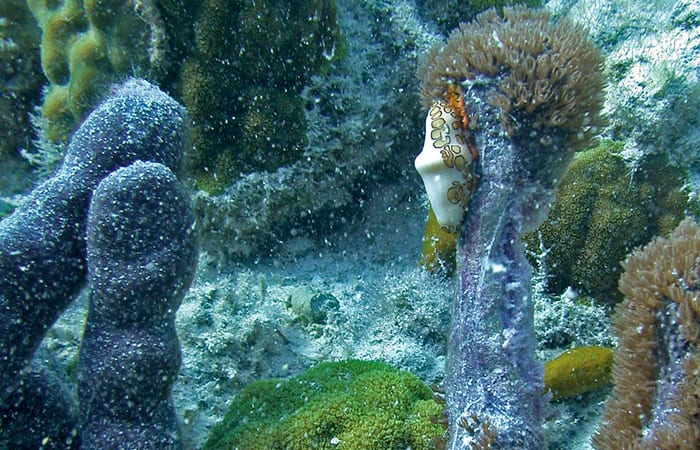
Biochemical Warfare on the Reef
In a co-evolutionary struggle, invertebrate adversaries develop weapon and counter-weapon
Just beneath the tranquil, clear waters of the tropical Caribbean, unseen by all but a few keen-eyed divers, two foes have engaged in a life-and-death struggle every day for thousands of millennia. Their limestone battlefield is peppered with a limitless variety of soft coral that look like easy targets for any hungry passerby. However, looks can be deceiving. These outwardly innocuous corals, commonly known as gorgonians, have a few tricks up their soft sleeves. They have evolved a powerful arsenal of chemical toxins that leave all who dare to consume them with a mouthful of distasteful compounds and a lesson they won’t soon forget.
The gorgonians’ chemical defenses do an excellent job of deterring most fishes and other large predators. But a handful of reef inhabitants have learned how to navigate the gorgonians’ toxic chemical mine-field and exploit these abundant corals for both food and shelter, giving themselves an edge over their fellow reef competitors.
A sea snail’s all-you-can-eat (toxic) buffet
At first glance the reclusive sea snail Cyphoma gibbosum, known as a “flamingo tongue” to most Floridians, appears harmless even skittish. It retracts its ornate mantle tissues inside its cream-colored shell at the mere passing of a shadow overhead. Yet, this single species of sea snail, no bigger than a postage stamp, has an insatiable appetite for gorgonians. This predator inflicts damage to more gorgonian colonies per year than even the most destructive hurricane.
Cyphoma leaves an unmistakable trail of feeding scars on gorgonians. The snails usually feed in roving hordes, munching their way through toxin-saturated tissue down to the corals’ hard skeleton. The sea snails use a modified tooth called a radula, chewing through tissue in a fashion similar to mowing a lawn. How this molluscan predator can overcome the gorgonians’ toxic chemical defenses – a feat unparalleled by the thousands of competing consumers on the reef—was the mystery that I hoped to solve.
Before I entered the WHOI/MIT Joint Program in 2002, I was introduced to the field of chemical ecology as an undergraduate at the University of North Carolina, Wilmington. Three times a year, we would pack up the lab, grab our wetsuits, and head south to the Florida Keys and the Bahamas to conduct experiments to assess the chemical defenses of Caribbean sponges.
Sponges in many ways are similar to their gorgonian cousins in that both are attached to the bottom and exposed to predators. Furthermore, both use similar noxious compounds to defend themselves against hungry consumers.
During forays into the field to study sponges, my attention strayed to their coral neighbors, where I caught my first glimpse of Cyphoma happily nibbling away on its toxic coral diet. I wondered how this snail was able to beat the system and consume a diet so rich in toxins and yet appear no worse for the wear? Little did I know that the answer to my question would come from understanding how the human body is able to cope with chemicals.
PharmEcology
In humans, the liver acts as the body’s filter. It breaks down and excretes a wide range of chemicals including drugs, alcohol, man-made toxicants and naturally-derived compounds found in our food. The processes controlling this incredible feat are carried out by a network of genes and enzymes, collectively termed a “defensome”, affording our bodies protection from chemical intoxication. Akin to the human liver, the digestive gland in Cyphoma is thought to contain genes and enzymes that carry out functions similar to their human counterparts, albeit fine tuned over evolutionary time scales to handle the marine toxins these snails encounter.
Working with my Ph.D. advisor Mark Hahn, senior scientist in the Biology Department at Woods Hole Oceanographic Institution, I have attempted to identify the genes and enzymes in the gut of Cyphoma that allows them to overcome the biochemical barrier imposed by the coral. We used our knowledge of gorgonian coral chemistry to identify those families of genes and enzymes in humans that would likely be responsible for metabolizing such compounds. Using this knowledge as a blueprint, we then looked for these same families of genes and enzymes in Cyphoma.
Once we identified several possible sea snail detoxification genes, the next step was to examine how these genes responded to the gorgonian compounds. In 2006, I collected sea snails and gorgonians from shallow reefs near the Perry Institute of Marine Science (PIMS) in the Bahamas. Back at the PIMS laboratory I allowed the sea snails to either feed on a gorgonian diet or a control diet lacking any coral compounds to examine how the expression of the genes varied when the sea snail was exposed to gorgonian compounds.
I found that the expression of one group of detoxification genes is “ramped up” in the digestive glands of Cyphoma feeding on specific gorgonian diets. These sea snail genes likely encode enzymes that are able to metabolize the very coral compounds responsible for their increased expression. These enzymes work by slapping an oxygen molecule onto the chemical intruder making it more water soluble and easier for the cell to excrete. But it seems that this family of enzymes is only capable of responding to and detoxifying a narrow range of coral compounds.
In contrast, a second family of enzymes was highly expressed in the digestive gland of Cyphoma regardless of the gorgonian diet. These enzymes assist by tagging the toxin with a special chemical flag, signaling the cell to expel out the toxin through gated pumps in the cell membrane. A follow-up series of experiments concluded that these proteins likely function as “all-purpose” detoxification enzymes, capable of “tagging” a broad range of gorgonian compounds.
Together, these results suggest that Cyphoma’s defensome is comprised of genes and enzymes that have both specific and varied detoxification roles, but work in concert to protect this predator from its toxin-laden prey.
For now the score appears to be Cyphoma 1, gorgonians 0—but I wouldn’t count the corals out of this co-evolutionary arms race just yet. If evolutionary theory has taught us anything, gorgonians are quietly developing novel toxins through spontaneous genetic mutation events that may one day confer an adaptive advantage in their direction. My advice to spectators: Stay tuned for the next 10,000 years of co-evolution.
This research was supported by a National Science Foundation Graduate Research Fellowship, the Cole-Ocean Ventures Fund (WHOI), a Tropical Research Initiative grant from the Ocean Life Institute (WHOI), and grants from SeaSpace and Conchologists of America.This article was written during a science writing course for graduate students at WHOI, supported by funds from The Henry L. and Grace Doherty Professor of Oceanography.
From the Series
Slideshow
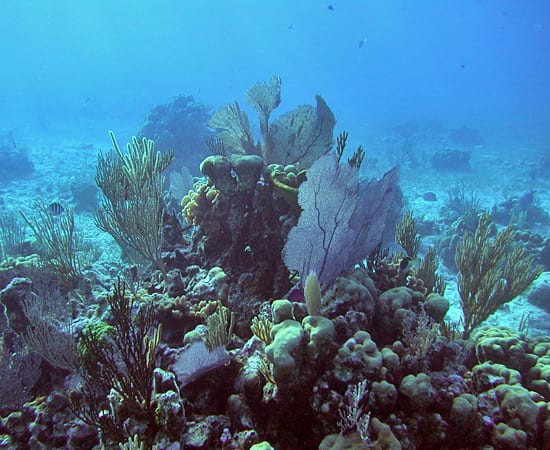
Slideshow
 The warm, shallow waters surrounding the Bahamas' Exuma Islands are home to a variety of corals, including soft corals also known as gorgonians. In this view are three types of gorgonians: sea fans (just right of center), sea whips (far right and far left), and sea plumes (in front of the large lavender sea fan.)
The warm, shallow waters surrounding the Bahamas' Exuma Islands are home to a variety of corals, including soft corals also known as gorgonians. In this view are three types of gorgonians: sea fans (just right of center), sea whips (far right and far left), and sea plumes (in front of the large lavender sea fan.)- Kristen Whalen, a graduate student in the MIT/WHOI Joint Program in Oceanography, collected gorgonian corals near the Perry Institute of Marine Science in the Exumas, Bahamas, and brought them back to the laboratory to analyze toxic chemical compounds they produce as a defense against animals eating them. Photo by Ann Tarrant, WHOI.
- An apparently peaceful scene (called "Rainbow Reef" for the variety of colorful reef organisms there, including orange encrusting sponges) belies the life-and-death struggle going on between soft corals—vulnerable, stationary, and edible—and mobile, voracious, predatory snails that can decimate the corals.
- Beautiful and damaging, "flamingo tongue" snails (Cyphoma gibbosum,) their orange spotted mantle tissue covering their shells, graze on the individual polyps (visible as tan dots on the coral branches) of a soft coral called the black sea rod (Plexaura homomalla), and leave white translucent egg masses behind as they consume the polyps. The corals' defense is to produce chemical weapons — toxic compounds that make them distasteful. The snail, though, possesses counter-weapons: biochemical mechanisms that detoxify the coral compounds.
- In a closer view, the coral polyps, the snails' mouths on the coral branch, and the scars the snails leave behind are clearly visible.
- The snail Cyphoma dining on one of its favorite meals, a purple gorgonian with fur-like brown tentacles named Biareum asbestinum, known locally as "dead man's fingers."
- Not deterred by the coral's chemical defense compounds, Cyphoma completely strips the coral of its polyps, leaving bare skeleton behind and visible in this close-up photo.
- Locked in combat on the reef, soft corals, over evolutionary time, developed poisonous compounds to deter consumers, while the marine snail Cyphoma evolved a "defensome"—a collection of genes and proteins that detoxify the compounds, and continues to graze on corals. Will there be a next step in the arms race?
Related Articles
Featured Researchers
See Also
- Kristen Whalen's most recent publication
- Kristen Whalen's home page
- Mark Hahn's Lab A focus of the laboratory is to understand the biochemical and molecular mechanisms that underlie the interactions of marine animals with their chemical environment.
- Perry Institute of Marine Science, Exumas, Bahamas
- University of North Carolina, Wilmington

